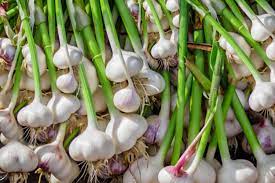Last Updated on April 10, 2024 by Real Men Sow
Garlic can be used in many dishes, so it is a popular choice to grow. It is also very easy to grow in all seasons. Although winter isn’t often associated with vegetables or fruits, some plants can tolerate the cold. Are you looking for a way to grow delicious winter garlic? This guide will help you grow winter garlic.
When Should You Start Your Winter Garlic?
Garlic requires temperatures below 40 °F for proper development. They also need to have enough time for roots to develop before the ground freezes. You should plant your garlic slightly before the first frost of each year, but not before a major freeze. Garlic is not a good choice for heat, so it’s best to plant garlic after the weather cools.
Most garlic plantings are done between September and November. For colder areas (USDA hardiness zone 3 and 4), it is best to plant garlic in September. However, milder regions (such as USDA zones 7 and 8) can wait until November.
Why You Should Grow Winter Garlic
Garlic planted in spring or summer will grow slower and be smaller than that planted in autumn. Because garlic requires cool weather to stimulate growth in its early stages of life but can be damaged by cold weather. The growing season for spring garlic must be completed before winter.
Planting in the fall also means that you will do less work overall. They require very little care because most root growth happens in winter. However, it can be more difficult to grow garlic in the summer because you need to create cold conditions for the clove to get the right size. Garlic is also heat sensitive. This means that you will need to do more to keep them cool in summer.
General Care Guide to Growing Winter Garlic
Soil
Garlic thrives in loamy soil that is well-drained, slightly acidic, and well-drained. To improve soil quality, you can add compost before planting. Before you plant, get rid of any weeds. You can grow garlic in a raised bed if your garden soil is not well-draining.
Sun Exposure
You should choose a location where there is enough sun. Garlic thrives on sun exposure of 6-8 hours per day.
Spacing
Space them apart a few inches. You can cover them with soil or mulch. Any mulch can be used, but straw is the most effective, especially in colder regions. Leave them to dry until spring.
Feeding
Remove your mulch after the last frost to allow the young leaves to grow. Garlic requires a lot of nitrogen so fertilize them with a high nitrogen fertilizer. Fertilize them twice a year: once in the spring, once in the spring, and once in the summer.
Water
Garlic requires the most water in late spring and early summer when the bulbs are starting to grow. They need to be watered every other day, or at least once a week. You can also stop watering them in the weeks before harvest. You can leave the leaves alone, but you should trim any flower stalks. This prevents the plant’s energy from being used for blooming and results in a smaller bulb.
Which Cloves to Use
You should use the healthiest, largest cloves possible. Make sure to inspect them for any signs of disease, discolouration or damage. Place each clove approximately two inches deep with the root side facing up.
Harvest
Most garlic can be harvested between June and July. However, a later planting will result in a later harvest. When the ends of the leaves turn yellow and wilty, it is time to harvest. They will likely need more nitrogen if they turn yellow before June.
To determine if the garlic bulbs are ready for harvest, first dig one bulb. To avoid damaging the garlic, be careful and use as few tools as you can. The skin should be thick enough to allow for gentle handling. Split bulbs are considered overripe. Thinner, more easily damaged skin is considered unripe. Once the test garlic has reached maturity, it is time to harvest the remainder of your garlic.


